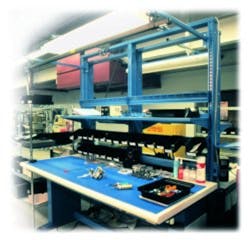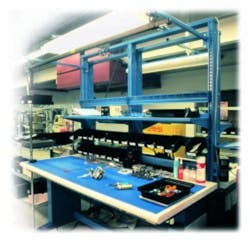The effectiveness of the ESD-control workstation is challenged by two well-defined types of static discharge. The human body model (HBM) and the charged device model (CDM) events present unique forms of threat that must be mastered to have an optimum work area.
The HBM event occurs when a charged human body comes in direct contact with an ESD-sensitive device. An event of this nature can be prevented by grounding each human who contacts the devices. The most common grounding methods at the workstation are a wrist strap, conductive footwear, and an antistatic chair or stool.
A CDM event occurs when a piece of metal, possibly a conveyor belt or a robotic arm, picks up a charge and then contacts a sensitive device. One way to prevent this type of event at the workstation is to divert the charge from every piece of equipment in the vicinity of the product to ground. This is accomplished by using a worksurface that drains electrical charges in a controlled manner.
Just like Goldilocks in the home of the Three Bears, you have three choices. A low-resistance conductive material may discharge the device too quickly, and a high-resistance insulating material drains the charge too slowly or possibly not at all. The medium-resistance dissipative work-surface, like Baby Bear’s bed, is just right. With a resistance between 106 W and 1012 W, it dissipates a static charge safely in a reasonable time.
Characteristics of a Good Workstation
The optimum static-control workstation addresses the basic threats of HBM and CDM events in a practical way. The goal in implementing a station is to make ESD control easy and intuitive. This is not a one-size-fits-all activity or a last-year-defines-this-year solution. The characteristics that pose ESD threats must be defined and reviewed frequently.
In the past, the driving forces in workstations primarily were their electrical properties. However, physical and chemical characteristics now are part of the equation. This has raised the price of a good station—but the value also has gone up significantly.
“The pressure to control ESD costs usually is not as strong in workstations as in other aspects of static control,” said David Swenson, an advanced technical service specialist at the 3M Electronic Handling and Protection Division. “Workstations can be used for several years if they are designed correctly.”
Users also are getting more knowledgeable about ESD. Jan Hoigaard, president of SpectraScan International, noted, “The typical user knows there are many mat types and will look for materials compatible with their workstation monitors. The astute buyer knows the ESD characteristics of the homogeneous mat under consideration or plays it safe and buys material that has a carbon-loaded backing or a carbon-loaded layer sandwiched between the top and bottom layers. The surface-to-carbon resistance of such a mat should be in the range of 107 W to 109 W.”
Cleanliness is another matter in which many workstation users are more concerned, particularly since the number of sensitive electronic parts being built in clean rooms now is greater than ever before. For example, outgassing and ionic contamination in clean-room workstations, frequent topics of concern today, rarely were discussed as little as one year ago.
The choice of chairs for the ESD-safe work area is critical, too. “Customers look for assurance that the seat has dissipative properties through all the components to the grounded base and drag chain,” noted James Frobose, director of engineering at BioFit Engineered Products. “Other factors involve selection of ESD-safe upholstery covers, metal components and static-control casters, and a grounding chain.”
Significant Industry Standards
Almost every discussion of ESD control begins with a reference to ANSI/ESD S20.20 for the development of an ESD program. Although it has been around for little more than a year, “S20.20 already has had a major influence on work-area design and verification, including worksurfaces,” said Mr. Swenson of 3M.1 “For example, the International Disk Drive Equipment and Materials Association (IDEMA) Document 231 relating to ESD control of AMR and GMR Heads references S20.20 for most static-control elements. In 231, however, the resistance-to-ground values are reduced from 1 × 109 W to reflect even tighter ESD controls than S20.20 for highly susceptible parts.”
Maintaining the Workstation
Installation of an ESD-safe workstation doesn’t ensure long-term static control. Sometimes grounding wires come loose, terminations on the worksurface corrode or lose continuity, or the worksurface is contaminated. As a result, the protective capability of the work site is degraded.
To combat these possible problems, it is important to verify proper workstation performance regularly and very often when the records show frequent failures. “As a verification history is built, the frequency of test should be adjusted to reflect the results of those records,” said Mr. Swenson of 3M. “The operator, the first line of defense at any workstation, also must be conscientious about checking the station daily to ensure that all ground wires are attached. Adding monitors and alarms to the workstation is another way to enhance checks and verify performance.”
Trends
While static-control characteristics of workstations are being driven by industry specifications such as those developed by the ESD Association, some users require even stricter control in their applications. For example, “While the standards state the resistance to ground for worksurfaces and ancillary components of the workstation should be <109 W,” noted Mr. Swenson, “we are seeing a trend bringing that value down. Many companies want less than 108 W to ground for these surfaces. Also, some industries, notably the disk-drive manufacturers, are requesting highly cushioned surfaces to reduce physical shock for trays of fragile components.”
Operational life of the worksurfaces as well as their performance will be improved is the opinion of Mark Reiland, product manager at Eagle Manufacturing, LLC. “A new technology, electrically conductive particleboard, can provide effective longevity to ESD workstations and worksurfaces,” he noted. “This laminate also transfers charges vertically rather than horizontally to simplify the grounding problem.”
Reference
- ANSI/ESD S20.20-1999, Standard for the Development of an Electrostatic Discharge Control Program for Protection of Electrical and Electronic Parts, Assemblies, and Equipment (Excluding Electrically Initiated Explosive Devices).
Acknowledgements
The following companies provided material for this article:
| ACL Staticide | 800-782-8420 |
| BioFit Engineered Products | 800-597-0246 |
| Eagle Manufacturing, LLC | 360-883-6627 |
| Lista International | 800-722-3020 |
| SpectraScan International | 719-447-0170 |
| 3M Electronic Handling and Protection Division |
800-814-8709 |
Published by EE-Evaluation Engineering
All contents © 2001 Nelson Publishing Inc.
No reprint, distribution, or reuse in any medium is permitted
without the express written consent of the publisher.
January 2001

